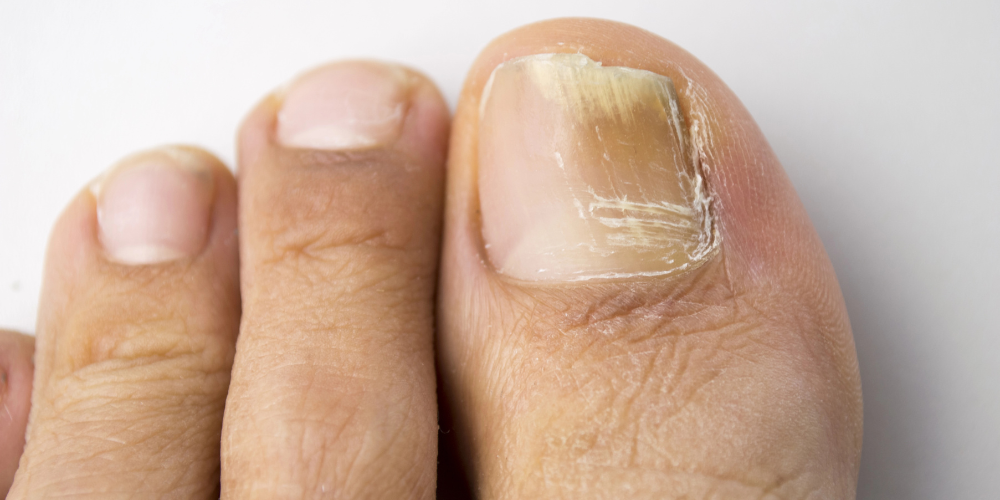Toenail fungus is more than just a cosmetic concern—it’s a persistent nuisance that can cause discomfort and embarrassment. But beyond its visible effects on toenails, there’s a lurking worry: Can toenail fungus spread to other parts of the body? This question underscores the need for a deeper understanding of fungal infections and their potential impact on overall health. While toenail fungus typically remains confined to the nails, there are instances where it can extend beyond, affecting adjacent skin or even spreading to other areas.
Continue reading to learn the mechanisms behind toenail fungal spread and preventative measures, including laser toenail treatment to improve overall foot health.
Toenail Fungus
Toenail fungus, or onychomycosis, develops when fungi, primarily dermatophytes, invade the nails, typically the toenails due to the warm and moist environment inside shoes. These fungi thrive in dark, damp areas, making the feet an ideal breeding ground. The infection usually begins as a small white or yellow spot under the nail, often unnoticed in its early stages.
As the fungus spreads, it can cause the nail to thicken, become discolored, and develop a brittle or crumbly texture. Factors such as poor foot hygiene, wearing tight or non-breathable shoes, walking barefoot in public places like pools or gym showers, and having a weakened immune system can increase the risk of toenail fungus. Additionally, individuals with conditions like diabetes or peripheral vascular disease are more susceptible to fungal infections.
Without laser treatment, toenail fungus can persist and spread to other nails, leading to discomfort, pain, and self-consciousness. Understanding the causes and risk factors of toenail fungus is essential for prevention and effective management.
Can Toenail Fungus Spread?
Now, onto the burning question: can toenail fungus spread beyond your toes? The short answer is yes, it can, but the likelihood and extent of spreading depend on various factors, including the type of fungus, your immune system, and your hygiene habits.
Potential Spread to Skin: One common route of spread is to the skin surrounding the toenails. If left untreated, toenail fungus can lead to skin irritation, redness, and itching around the affected nails. This is because the fungus can migrate from the nail bed to the nearby skin, causing a condition known as tinea pedis or athlete’s foot.
Transmission to Other Nails: Another concern is the spread of toenail fungus to other nails, both on the same foot and on the opposite foot. This can occur through direct contact with infected nails or by sharing contaminated items such as nail clippers or towels. Once the fungus establishes itself on one nail, it can easily move to neighboring nails if preventive measures are not taken.
Risk of Systemic Infection
While rare, severe cases of toenail fungus can potentially lead to systemic infection, especially in individuals with compromised immune systems. In such cases, the fungus may enter the bloodstream and spread to other parts of the body, including vital organs. However, this is uncommon and typically occurs in individuals with underlying health conditions or immune deficiencies.
Prevention Is Key
The good news is that there are steps you can take to reduce the risk of toenail fungus spreading. These include:
Maintaining Good Hygiene: Keep your feet clean and dry, especially between the toes. Wear clean socks made of breathable materials and change them regularly, especially if your feet tend to sweat.
Wearing Protective Footwear: Choose shoes that allow air circulation and avoid wearing tight-fitting or damp shoes for prolonged periods. When using public showers or swimming pools, wear waterproof sandals to minimize direct contact with contaminated surfaces.
Avoiding Nail Trauma: Protect your toenails from injury and trauma, as this can create entry points for fungi. Trim nails straight across and avoid cutting them too short to prevent ingrown nails.
Treating Promptly: If you suspect you have toenail fungus, seek laser toenail fungus treatment promptly. Early intervention can help prevent the spread of the infection to other nails or areas of the body.
Laser Toenail Fungus Treatment
Laser toenail fungus treatment has emerged as a promising solution for individuals grappling with stubborn fungal infections affecting their toenails. This non-invasive procedure utilizes focused laser beams to penetrate the nail bed and target the fungal infection at its source. The laser emits wavelengths that effectively kill the fungus while leaving surrounding tissues unharmed, making it a safe and efficient option.
During the procedure, patients typically experience minimal discomfort, with some reporting a warming sensation in the treated area. Multiple sessions may be required depending on the severity of the infection. However, many individuals notice significant improvement after just a few treatments.
One of the key advantages of laser toenail fungus treatment is its high success rate compared to traditional methods such as oral antifungal medications or topical treatments. Additionally, it eliminates the need for potentially harmful medications and lengthy recovery periods associated with invasive procedures.
While laser toenail fungus treatment offers promising results, it’s essential to consult with a qualified healthcare provider to determine if it’s the right option for you. With its effectiveness, minimal discomfort, and convenience, laser treatment presents a viable solution for those seeking to rid themselves of stubborn toenail fungus and restore healthy, clear nails.
Conclusion
While toenail fungus can indeed spread beyond your toes, it’s important to remember that with proper care and laser toenail fungus treatment, you can minimize the risk of transmission and prevent further complications. By practicing good foot hygiene, wearing appropriate footwear, and seeking timely treatment, you can keep toenail fungus in check and maintain healthy, happy feet.








